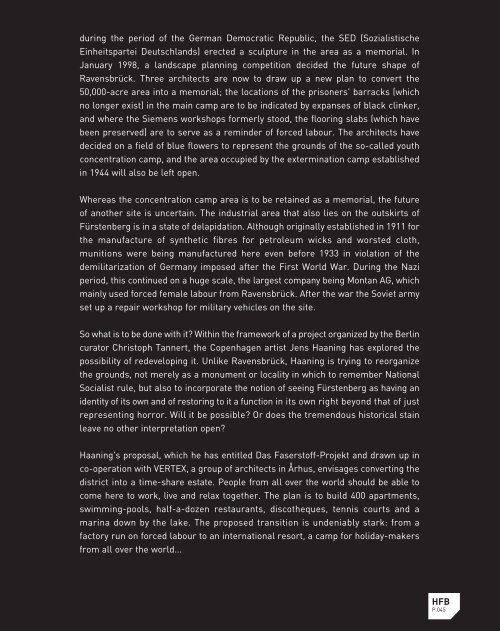download catalogue high resolution pdf (22.3 mb) - Jens Haaning
download catalogue high resolution pdf (22.3 mb) - Jens Haaning
download catalogue high resolution pdf (22.3 mb) - Jens Haaning
You also want an ePaper? Increase the reach of your titles
YUMPU automatically turns print PDFs into web optimized ePapers that Google loves.
during the period of the German Democratic Republic, the SED (Sozialistische<br />
Einheitspartei Deutschlands) erected a sculpture in the area as a memorial. In<br />
January 1998, a landscape planning competition decided the future shape of<br />
Ravensbrück. Three architects are now to draw up a new plan to convert the<br />
50,000-acre area into a memorial; the locations of the prisoners' barracks (which<br />
no longer exist) in the main camp are to be indicated by expanses of black clinker,<br />
and where the Siemens workshops formerly stood, the flooring slabs (which have<br />
been preserved) are to serve as a reminder of forced labour. The architects have<br />
decided on a field of blue flowers to represent the grounds of the so-called youth<br />
concentration camp, and the area occupied by the extermination camp established<br />
in 1944 will also be left open.<br />
Whereas the concentration camp area is to be retained as a memorial, the future<br />
of another site is uncertain. The industrial area that also lies on the outskirts of<br />
Fürstenberg is in a state of delapidation. Although originally established in 1911 for<br />
the manufacture of synthetic fibres for petroleum wicks and worsted cloth,<br />
munitions were being manufactured here even before 1933 in violation of the<br />
demilitarization of Germany imposed after the First World War. During the Nazi<br />
period, this continued on a huge scale, the largest company being Montan AG, which<br />
mainly used forced female labour from Ravensbrück. After the war the Soviet army<br />
set up a repair workshop for military vehicles on the site.<br />
So what is to be done with it? Within the framework of a project organized by the Berlin<br />
curator Christoph Tannert, the Copenhagen artist <strong>Jens</strong> <strong>Haaning</strong> has explored the<br />
possibility of redeveloping it. Unlike Ravensbrück, <strong>Haaning</strong> is trying to reorganize<br />
the grounds, not merely as a monument or locality in which to reme<strong>mb</strong>er National<br />
Socialist rule, but also to incorporate the notion of seeing Fürstenberg as having an<br />
identity of its own and of restoring to it a function in its own right beyond that of just<br />
representing horror. Will it be possible? Or does the tremendous historical stain<br />
leave no other interpretation open?<br />
<strong>Haaning</strong>'s proposal, which he has entitled Das Faserstoff-Projekt and drawn up in<br />
co-operation with VERTEX, a group of architects in Århus, envisages converting the<br />
district into a time-share estate. People from all over the world should be able to<br />
come here to work, live and relax together. The plan is to build 400 apartments,<br />
swimming-pools, half-a-dozen restaurants, discotheques, tennis courts and a<br />
marina down by the lake. The proposed transition is undeniably stark: from a<br />
factory run on forced labour to an international resort, a camp for holiday-makers<br />
from all over the world...<br />
HFB<br />
P.045


